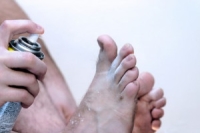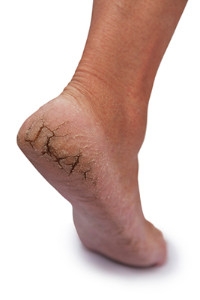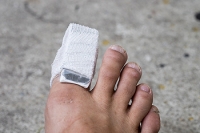
Blog (807)
What causes Athlete’s Foot?
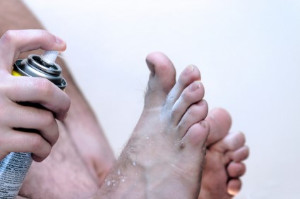 If you experience a fungus that affects your feet, you may have what is referred to as athlete’s foot. Common symptoms of this condition may include itching, blistering, or cracked skin. If you develop athlete’s foot, it’s advised to seek treatment as soon as possible so infection can be prevented. The fungus typically thrives in moist environments, and may live on shower room floors or in public pools. Athlete’s foot can easily spread, and it’s recommended that shower shoes are worn to possibly prevent this fungus from entering the skin. Additional preventive measures may include washing the feet and drying thoroughly between the toes, using a powder to absorb excessive moisture, and avoiding wearing shoes that fit incorrectly. If you have athlete’s foot, please consult with a podiatrist for additional information about prevention and treatment options.
If you experience a fungus that affects your feet, you may have what is referred to as athlete’s foot. Common symptoms of this condition may include itching, blistering, or cracked skin. If you develop athlete’s foot, it’s advised to seek treatment as soon as possible so infection can be prevented. The fungus typically thrives in moist environments, and may live on shower room floors or in public pools. Athlete’s foot can easily spread, and it’s recommended that shower shoes are worn to possibly prevent this fungus from entering the skin. Additional preventive measures may include washing the feet and drying thoroughly between the toes, using a powder to absorb excessive moisture, and avoiding wearing shoes that fit incorrectly. If you have athlete’s foot, please consult with a podiatrist for additional information about prevention and treatment options.
Athlete’s foot is an inconvenient condition that can be easily reduced with the proper treatment. If you have any concerns about your feet and ankles, contact Dr. Kenneth Donovan from Advanced Care Foot and Ankle. Our doctor will treat your foot and ankle needs.
Athlete’s Foot: The Sole Story
Athlete's foot, also known as tinea pedis, can be an extremely contagious foot infection. It is commonly contracted in public changing areas and bathrooms, dormitory style living quarters, around locker rooms and public swimming pools, or anywhere your feet often come into contact with other people.
Solutions to Combat Athlete’s Foot
- Hydrate your feet by using lotion
- Exfoliate
- Buff off nails
- Use of anti-fungal products
- Examine your feet and visit your doctor if any suspicious blisters or cuts develop
Athlete’s foot can cause many irritating symptoms such as dry and flaking skin, itching, and redness. Some more severe symptoms can include bleeding and cracked skin, intense itching and burning, and even pain when walking. In the worst cases, Athlete’s foot can cause blistering as well. Speak to your podiatrist for a better understanding of the different causes of Athlete’s foot, as well as help in determining which treatment options are best for you.
If you have any questions please feel free to contact one of our offices located in Warren, Livingston, and Toms River, NJ . We offer the newest diagnostic and treatment technologies for all your foot and ankle needs.
Before you start dancing…
Before you start dancing...
Causes of Cracked Heels
Cracked heels is a foot condition that typically develops from pressure endured by the feet from standing for long periods of time. Additional causes can include wearing shoes that fail to support the foot correctly or being overweight, possibly causing the skin on the heels to crack under the additional pressure. There may also be medical conditions that can contribute to developing this condition including athlete’s foot, psoriasis, or eczema. Lack of consuming proper amounts of water can lead to having cracked heels, so it’s wise to hydrate frequently to prevent the skin from becoming excessively dry. There are several ways to prevent this ailment from occurring, which may include dietary changes, choosing shoes that properly support the heel of the foot, and utilizing a moisturizer that will help the skin to soften. A consultation with a podiatrist is suggested for additional information on how to treat cracked heels.
Cracked heels are unsightly and can cause further damage to your shoes and feet. If you have any concerns, contact Dr. Kenneth Donovan from Advanced Care Foot and Ankle. Our doctor can provide the care you need to keep you pain-free and on your feet.
Cracked Heels
Cracked heels appear unappealing and can make it harder for you walk around in sandals. Aside from looking unpleasant, cracked heels can also tear stockings, socks, and wear out your shoes. There are several methods to help restore a cracked heel and prevent further damage.
How Do You Get Them?
Dry skin is the number one culprit in creating cracked heels. Many athletes, walkers, joggers, and even swimmers suffer from cracked heels. Age and skin oil production play a role to getting cracked heels as well.
Promote Healing
Over the counter medicines can help, especially for those that need instant relief or who suffer from chronic dry feet.
Wear Socks – Wearing socks with medicated creams helps lock in moisture.
Moisturizers – Applying both day and night will help alleviate dryness which causes cracking.
Pumice Stones – These exfoliate and remove dead skin, which allows for smoother moisturizer application and better absorption into the skin.
Eating healthy with a well-balanced diet will give the skin a fresh and radiant look. Your body responds to the kinds of food you ingest. Omega-3 fatty acids and zinc supplements can also revitalize skin tissue.
Most importantly, seek professional help if unsure how to proceed in treating cracked heels.
A podiatrist will help you with any questions or information needed.
If you have any questions, please feel free to contact one of our offices located in Warren, Livingston, and Toms River, NJ. We offer the newest diagnostic and treatment technologies for all your foot care needs.
Causes of Cracked Heels
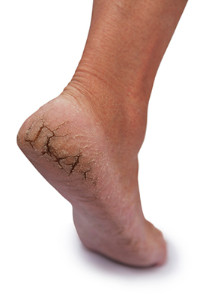 Cracked heels is a foot condition that typically develops from pressure endured by the feet from standing for long periods of time. Additional causes can include wearing shoes that fail to support the foot correctly or being overweight, possibly causing the skin on the heels to crack under the additional pressure. There may also be medical conditions that can contribute to developing this condition including athlete’s foot, psoriasis, or eczema. Lack of consuming proper amounts of water can lead to having cracked heels, so it’s wise to hydrate frequently to prevent the skin from becoming excessively dry. There are several ways to prevent this ailment from occurring, which may include dietary changes, choosing shoes that properly support the heel of the foot, and utilizing a moisturizer that will help the skin to soften. A consultation with a podiatrist is suggested for additional information on how to treat cracked heels.
Cracked heels is a foot condition that typically develops from pressure endured by the feet from standing for long periods of time. Additional causes can include wearing shoes that fail to support the foot correctly or being overweight, possibly causing the skin on the heels to crack under the additional pressure. There may also be medical conditions that can contribute to developing this condition including athlete’s foot, psoriasis, or eczema. Lack of consuming proper amounts of water can lead to having cracked heels, so it’s wise to hydrate frequently to prevent the skin from becoming excessively dry. There are several ways to prevent this ailment from occurring, which may include dietary changes, choosing shoes that properly support the heel of the foot, and utilizing a moisturizer that will help the skin to soften. A consultation with a podiatrist is suggested for additional information on how to treat cracked heels.
Cracked heels are unsightly and can cause further damage to your shoes and feet. If you have any concerns, contact Dr. Kenneth Donovan from Advanced Care Foot and Ankle. Our doctor can provide the care you need to keep you pain-free and on your feet.
Cracked Heels
Cracked heels appear unappealing and can make it harder for you walk around in sandals. Aside from looking unpleasant, cracked heels can also tear stockings, socks, and wear out your shoes. There are several methods to help restore a cracked heel and prevent further damage.
How Do You Get Them?
Dry skin is the number one culprit in creating cracked heels. Many athletes, walkers, joggers, and even swimmers suffer from cracked heels. Age and skin oil production play a role to getting cracked heels as well.
Promote Healing
Over the counter medicines can help, especially for those that need instant relief or who suffer from chronic dry feet.
Wear Socks – Wearing socks with medicated creams helps lock in moisture.
Moisturizers – Applying both day and night will help alleviate dryness which causes cracking.
Pumice Stones – These exfoliate and remove dead skin, which allows for smoother moisturizer application and better absorption into the skin.
Change in Diet
Eating healthy with a well-balanced diet will give the skin a fresh and radiant look. Your body responds to the kinds of food you ingest. Omega-3 fatty acids and zinc supplements can also revitalize skin tissue.
Most importantly, seek professional help if unsure how to proceed in treating cracked heels. A podiatrist will help you with any questions or information needed.
If you have any questions, please feel free to contact one of our offices located in Warren, Livingston, and Toms River, NJ . We offer the newest diagnostic and treatment technologies for all your foot care needs.
Read more about Solutions for Cracked HeelsClearanail Treats Toenail Fungus
Advanced Care Foot and Ankle is happy to offer cutting edge technology in the battle against nail fungus. Introducing Clearanail, the advanced micro drilling system for the treatment of onychomycosis. Utilizing Clearanail’s patented technology, we are able to drill precise 0.4mm holes into the infected nail plate, allowing access to the diseased nail bed.
For decades, people have struggled to treat nail fungus. Topical medications have been shown to inadequately penetrate the nail plate, leading to poor outcomes. Even newer topical medications are brand name drugs with little insurance coverage and high out of pocket costs. Oral medications have been one of the more effective treatments, but have to be taken for prolonged periods of time, increasing the chance of potential side effects. Also, some patients are not candidates for oral therapy, due to their past medical history and interactions with their current medications. Lastly, there is the method of using a nail laser, a very expensive treatment option with little success rate.
The medical field has known for years that the majority of infections of the skin and/or nail are caused by dermatophytes, relatively easy organisms to kill. We know this because when patients suffer from “Athlete’s foot,” a fungal infection of the skin, the dermatophytes are easily killed with topical medication. When the dermatophytes get under the nail, however, topical medications struggle to penetrate down into the underlying nail bed where the organisms reside. This is where Clearanail microdrilling technology comes into play. In less than 20 minutes, multiple micro pathways are created in the nail plate without pain or discomfort. This is done with a special fail-safe sensor on the drill that detects when the nail plate is penetrated and shuts off automatically.
After the creation of the pathways, patients then apply a low-cost topical medication regularly to the nail, which easily absorbs through the nail plate to kill the fungus. Patient are seeing results within 2-8 weeks from the start of treatment. Come in today to try this new advanced treatment option for nail fungus at any of our office locations!
I’ve Fallen and Injured My Toe – Have I Broken It?
If you’ve broken your toe, the chances are favorable that your toe endured trauma, generally due to a heavy object falling on it or possibly stubbing it and causing it to jam. The two toes that most often experience a fracture are the pinky and the big toe. This seldom occurs in the other toes because they are protected by the toes next to them. One of the first signs of a broken toe may include pain and swelling, in addition to possible bruising in the affected toe and surrounding area. If the bone appears to be protruding, often occurring after a harsh fall, an X-ray may be necessary to determine the severity of the fracture. Treatment may consist of taping the toe to the one next to it or utilizing a splint for the affected toe. It’s suggested to consult with a podiatrist to learn more about symptoms and treatment options for a broken toe.
A broken toe can be very painful and lead to complications if not properly fixed. If you have any concerns about your feet, contact Dr. Kenneth Donovan from Advanced Care Foot and Ankle. Our doctor will treat your foot and ankle needs.
What to Know About a Broken Toe
Although most people try to avoid foot trauma such as banging, stubbing, or dropping heavy objects on their feet, the unfortunate fact is that it is a common occurrence. Given the fact that toes are positioned in front of the feet, they typically sustain the brunt of such trauma. When trauma occurs to a toe, the result can be a painful break (fracture).
Symptoms of a Broken Toe
- Throbbing pain
- Swelling
- Bruising on the skin and toenail
- The inability to move the toe
- Toe appears crooked or disfigured
- Tingling or numbness in the toe
Generally, it is best to stay off of the injured toe with the affected foot elevated.
Severe toe fractures may be treated with a splint, cast, and in some cases, minor surgery. Due to its position and the pressure it endures with daily activity, future complications can occur if the big toe is not properly treated.
If you have any questions please feel free to contact one of our offices located in Warren, Livingston, and Toms River, NJ. We offer the newest diagnostic and treatment technologies for all your foot and ankle needs.
I’ve Fallen and Injured My Toe - Have I Broken It?
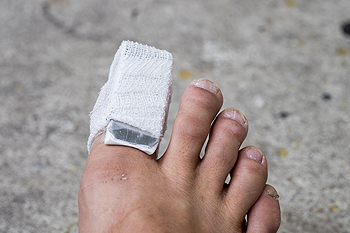 If you’ve broken your toe, the chances are favorable that your toe endured trauma, generally due to a heavy object falling on it or possibly stubbing it and causing it to jam. The two toes that most often experience a fracture are the pinky and the big toe. This seldom occurs in the other toes because they are protected by the toes next to them. One of the first signs of a broken toe may include pain and swelling, in addition to possible bruising in the affected toe and surrounding area. If the bone appears to be protruding, often occurring after a harsh fall, an X-ray may be necessary to determine the severity of the fracture. Treatment may consist of taping the toe to the one next to it or utilizing a splint for the affected toe. It’s suggested to consult with a podiatrist to learn more about symptoms and treatment options for a broken toe.
If you’ve broken your toe, the chances are favorable that your toe endured trauma, generally due to a heavy object falling on it or possibly stubbing it and causing it to jam. The two toes that most often experience a fracture are the pinky and the big toe. This seldom occurs in the other toes because they are protected by the toes next to them. One of the first signs of a broken toe may include pain and swelling, in addition to possible bruising in the affected toe and surrounding area. If the bone appears to be protruding, often occurring after a harsh fall, an X-ray may be necessary to determine the severity of the fracture. Treatment may consist of taping the toe to the one next to it or utilizing a splint for the affected toe. It’s suggested to consult with a podiatrist to learn more about symptoms and treatment options for a broken toe.
A broken toe can be very painful and lead to complications if not properly fixed. If you have any concerns about your feet, contact Dr. Kenneth Donovan from Advanced Care Foot and Ankle. Our doctor will treat your foot and ankle needs.
What to Know About a Broken Toe
Although most people try to avoid foot trauma such as banging, stubbing, or dropping heavy objects on their feet, the unfortunate fact is that it is a common occurrence. Given the fact that toes are positioned in front of the feet, they typically sustain the brunt of such trauma. When trauma occurs to a toe, the result can be a painful break (fracture).
Symptoms of a Broken Toe
- Throbbing pain
- Swelling
- Bruising on the skin and toenail
- The inability to move the toe
- Toe appears crooked or disfigured
- Tingling or numbness in the toe
Generally, it is best to stay off of the injured toe with the affected foot elevated.
Severe toe fractures may be treated with a splint, cast, and in some cases, minor surgery. Due to its position and the pressure it endures with daily activity, future complications can occur if the big toe is not properly treated.
If you have any questions please feel free to contact one of our offices located in Warren, Livingston, and Toms River, NJ . We offer the newest diagnostic and treatment technologies for all your foot and ankle needs.
The Importance of Caring for Elderly Feet
It’s not unusual for elderly people to experience complications concerning the feet. It’s common for the feet to lose support and cushioning as one ages. Additionally, poor circulation often develops, which may cause any sores on the feet to heal slowly. It’s advisable to wear shoes that are comfortable and have adequate support, and it’s also suggested to avoid shoes that are too tight and that may cause blisters and corns. Trimming the toenails straight across will stop the corners from digging into the skin and may help avoid ingrown toenails. A common foot issue that many elderly people have to contend with is a fungal infection that targets the toes and nails. A diabetic patient must pay extra special attention to the care of the feet. This includes keeping the feet clean by washing them daily in warm water and wearing clean and absorbent socks. Please consider scheduling a consultation with a podiatrist for additional information on how to care for elderly feet.
Proper foot care is something many older adults forget to consider. If you have any concerns about your feet and ankles, contact Dr. Kenneth Donovan from Advanced Care Foot and Ankle. Our doctor can provide the care you need to keep you pain-free and on your feet.
The Elderly and Their Feet
As we age we start to notice many changes in our body, but the elder population may not notice them right away. Medical conditions may prevent the elderly to take notice of their foot health right away. Poor vision is a lead contributor to not taking action for the elderly.
Common Conditions
- Neuropathy – can reduce feeling in the feet and can hide many life-threatening medical conditions.
- Reduced flexibility – prevents the ability of proper toenail trimming, and foot cleaning. If left untreated, it may lead to further medical issues.
- Foot sores – amongst the older population can be serious before they are discovered. Some of the problematic conditions they may face are:
- Gouging toenails affecting nearby toe
- Shoes that don’t fit properly
- Pressure sores
- Loss of circulation in legs & feet
- Edema & swelling of feet and ankles
Susceptible Infections
Diabetes and poor circulation can cause general loss of sensitivity over the years, turning a simple cut into a serious issue.
If you have any questions please feel free to contact one of our offices located in Warren, Livingston, and Toms River, NJ. We offer the newest diagnostic and treatment technologies for all your foot and ankle needs.
